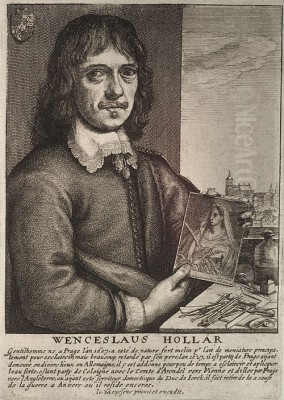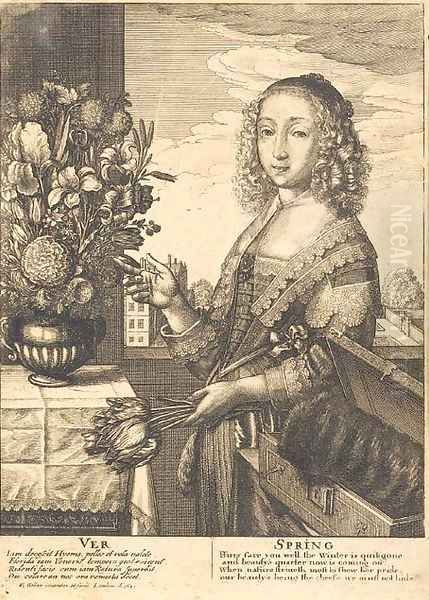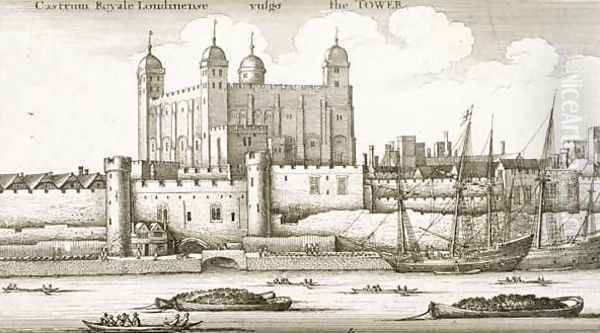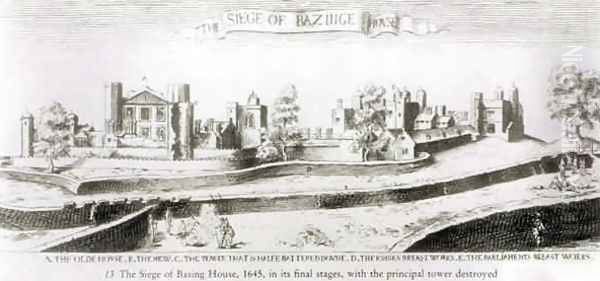
Wenceslaus Hollar stands as one of the most prolific and significant printmakers of the 17th century. Born in Prague during a tumultuous period in European history, his life and career spanned across the continent, most notably finding a long-term, if not always prosperous, home in England. A master of the etching needle, Hollar produced an astonishing number of prints – estimated between 2,400 and 2,700 plates – covering an exceptionally wide range of subjects. His work is prized not only for its technical brilliance and aesthetic quality but also for its invaluable role as a documentary record of the places, people, events, and even the natural world of his time. From detailed cityscapes and landscapes to portraits, costume studies, and natural history illustrations, Hollar's meticulous eye captured his world with remarkable fidelity.
Early Life and Artistic Awakening in Bohemia and Germany
Wenceslaus Hollar, or Václav Hollar in his native Czech, was born in Prague on July 13, 1607. He hailed from a family of the lower nobility; his father, Jan Hollar, served as a municipal official in the city. The family was Protestant, a factor that would significantly shape Hollar's life path, particularly given the religious conflicts engulfing Bohemia and Europe during the Thirty Years' War (1618-1648). The Hollar family suffered financial setbacks due to the war, losing property and status.
Initially, Hollar's father intended for him to pursue a career in law. However, the young Wenceslaus displayed a strong inclination towards art from an early age. His passion for drawing and map-making ultimately won out over legal studies. The volatile political and religious situation in Prague following the Battle of White Mountain (1620) and the subsequent re-Catholicization likely contributed to his decision to leave his homeland.

In 1627, seeking artistic training and opportunities unavailable to him as a Protestant in Prague, Hollar travelled to Germany. He settled initially in Frankfurt am Main, a major centre for printing and publishing. There, he entered the workshop of one of the era's most renowned engravers and publishers, Matthäus Merian the Elder. Under Merian's tutelage, Hollar honed his skills in etching and engraving, particularly in the precise rendering of topographical views and maps, skills that would become hallmarks of his career.
Travels and Early Career on the Continent
After his apprenticeship with Merian, Hollar did not immediately settle. Between roughly 1630 and 1634, he travelled and worked in various cities in southwestern Germany and the Low Countries. He spent time in Strasbourg, Mainz, and Cologne, continuing to develop his craft. During this period, he focused primarily on producing topographical prints, capturing detailed views of cities, landscapes, and castles along the Rhine River and elsewhere. These early works already demonstrated his keen observational skills and his ability to render architectural detail and atmospheric perspective with clarity and precision.
His travels exposed him to various artistic currents and likely brought him into contact with the works of other prominent artists. The influence of earlier topographical artists like Joris Hoefnagel can be discerned in Hollar's approach to city views, blending accuracy with a degree of artistic composition. His time in Germany and the Low Countries solidified his reputation as a skilled draughtsman and etcher, capable of producing high-quality prints that appealed to a growing market for topographical and illustrative works.
Arrival in England and the Patronage of the Earl of Arundel
A pivotal moment in Hollar's career occurred in 1636. While working in Cologne, he encountered Thomas Howard, the 2nd Earl of Arundel. Arundel, one of England's foremost art collectors and connoisseurs, was travelling through Europe on a diplomatic mission to the Holy Roman Emperor in Vienna. Impressed by Hollar's talent, Arundel invited the artist to join his retinue. Hollar accompanied the Earl on his journey down the Danube and eventually back to England, arriving in London in 1637.
This marked the beginning of a long and significant, though not always financially secure, association. Arundel became Hollar's most important early patron in England, employing him as a draughtsman and etcher. Hollar was tasked with documenting parts of the Earl's extensive art collection, housed in Arundel House on the Strand. He produced etchings after drawings and paintings by masters such as Leonardo da Vinci and Hans Holbein the Younger from the collection. This work provided Hollar with invaluable access to high-quality art and further refined his skills.

Living and working within the Arundel household placed Hollar at the centre of artistic and intellectual life in London. Arundel House was a hub for artists, scholars, and collectors. This environment undoubtedly broadened Hollar's horizons and provided him with numerous commissions, although his remuneration was often modest. He began to establish himself within the London art scene, producing prints for various publishers and patrons beyond Arundel.
Master Etcher: Technique and Diverse Subjects
Hollar's primary medium was etching, a technique he mastered with exceptional skill. While engraving involves cutting directly into the metal plate, etching uses acid to bite lines into a plate coated with a protective ground, allowing for greater freedom and fluidity of line, akin to drawing. Hollar was among the first artists to extensively practice and popularize etching in England, bringing a level of sophistication and detail previously uncommon in English printmaking. His technique was characterized by fine, precise lines, delicate cross-hatching for shading, and an ability to convey texture and atmosphere effectively.
His subject matter was remarkably diverse. He continued to produce topographical views, which became some of his most celebrated works. His detailed panoramas and individual views of London, before and particularly after the Great Fire, are iconic. He also etched views of other English towns, Continental cities like Antwerp and Strasbourg, and even distant locations like Tangier. Architectural studies, such as his detailed etching of Antwerp Cathedral, showcase his precision.
Beyond topography, Hollar excelled in various other genres. He produced numerous portraits, often based on paintings by other artists like Anthony van Dyck or Peter Lely, but also original studies. He created series dedicated to fashion, such as the Ornatus Muliebris Anglicanus (English Women's Attire), providing valuable records of contemporary dress. Natural history also captured his interest; he etched exquisite studies of insects, shells, flowers, and animals, sometimes collected in series like Muscarum Scarabeorum Vermiumque Variae Figurae or A New Boock of Flowers, Beasts, Birds. Allegorical subjects, like his series of "The Four Seasons" personified as women in appropriate settings, and religious themes also feature in his oeuvre, alongside numerous book illustrations for publishers.
Documenting a Turbulent Era: Civil War and the Great Fire

Hollar lived and worked in England during one of its most turbulent periods, encompassing the English Civil War (1642-1651), the Commonwealth (1649-1660), and the Restoration of the Monarchy (1660). His work provides a unique visual chronicle of these times. Although his patron, the Earl of Arundel, was a Royalist and left England in 1642, Hollar initially remained. He produced prints related to the conflict, including depictions of soldiers and fortifications. However, his Royalist sympathies eventually led him to leave London.
Around 1644, Hollar travelled to Antwerp, where Arundel had settled. He remained there for several years, continuing to work prolifically, producing views of the city and collaborating with local artists and publishers, possibly including figures like the engraver Abraham von Rosenberg. He returned to London in 1652, during the Commonwealth period. Despite the political changes, he found work illustrating books for publishers like John Ogilby.
The Restoration of Charles II in 1660 brought renewed opportunities, though not necessarily financial security. Hollar received royal favour, being appointed "His Majesty's Scenographer" or "Designer Royal" in 1660. One of his most significant achievements during this period was the creation of his monumental "Long View of London from Bankside," completed around 1647 but likely based on drawings made before his departure to Antwerp. This panoramic view provides an invaluable record of the city before the Great Fire.
His skills as a topographical artist were particularly crucial after the catastrophic Great Fire of London in September 1666. Hollar produced several views documenting the devastation, including dramatic scenes of the burning city and detailed depictions of the ruins, most notably the shell of St. Paul's Cathedral. He also created maps and plans related to the rebuilding efforts. These prints are among the most important visual records of this pivotal event in London's history.
Royal Service, the Tangier Expedition, and Later Career
Despite his royal appointment and the evident quality of his work, Hollar struggled financially throughout much of his career. He often worked for publishers at low rates, paid by the hour, and found it difficult to earn a comfortable living solely from his art. His meticulous, time-consuming technique may have contributed to this; while it resulted in high-quality prints, it limited the speed at which he could produce plates compared to artists with a looser style.

In 1668, Hollar embarked on an adventurous journey that reflected his royal service. He was sent by King Charles II to the English possession of Tangier on the coast of Morocco. His mission was to create accurate drawings of the city, its fortifications, and the surrounding landscape. This expedition was not without peril; the return voyage in 1669 involved an engagement with Algerian pirates, an event Hollar later depicted in one of his etchings.
The Tangier expedition resulted in a series of highly detailed and informative prints, showcasing the North African environment, the architecture of the city, and views of the English garrison and harbour. These works stand out in his oeuvre for their exotic subject matter and demonstrate his continued ability to adapt his precise style to new environments. They remain important historical documents relating to this period of English colonial history.
Artistic Style, Technique, and Contemporaries
Hollar's artistic style is defined by its clarity, precision, and objectivity. He aimed for topographical accuracy and detailed representation, whether depicting a cityscape, a costume, or an insect. His line work in etching is typically fine and controlled, using systematic hatching and cross-hatching to build tone and volume. While capable of capturing atmospheric effects, his primary focus was often on rendering detail and form faithfully. His compositions are generally straightforward and descriptive, prioritizing information over dramatic effect.
His style reflects a blend of influences. The meticulous topographical tradition of German and Flemish artists like Merian and Hoefnagel is evident. His time in England exposed him to the portraiture styles of Van Dyck and Lely, whose works he sometimes translated into prints. His detailed natural history studies align with a broader European interest in scientific observation and illustration during the 17th century. While contemporary master etchers like Rembrandt van Rijn explored expressive line and dramatic chiaroscuro, Hollar pursued a path of descriptive clarity and refinement.
Hollar interacted with numerous figures in the art world. Key connections include his teacher Matthäus Merian the Elder, his patron Thomas Howard, Earl of Arundel, and his royal patrons Charles I and Charles II. In England, he would have known or encountered leading court painters like Anthony van Dyck and his successor Peter Lely. He collaborated with publishers such as John Ogilby and mapmakers. He also knew fellow printmakers and draughtsmen, such as Francis Place, a Yorkshire-born gentleman artist who also worked in etching and topography. The broader European context includes influential etchers like Jacques Callot, whose technical innovations impacted the medium across the continent.
Financial Struggles and Final Years
Despite his prolific output, undeniable skill, and connections to powerful patrons, Wenceslaus Hollar faced persistent financial difficulties throughout his life. The market for prints was competitive, and publishers often paid artists poorly, especially for book illustrations or reproductive work. Hollar's dedication to meticulous detail meant his work was labour-intensive, potentially limiting his earnings compared to artists who could produce plates more quickly.
His later years were marked by poverty. Anecdotal accounts suggest that even as he lay dying, bailiffs were present to seize his belongings for debt. Wenceslaus Hollar died in London on March 25, 1677, at the age of nearly 70. He was buried three days later at St Margaret's Church, Westminster, a testament to his long association with the city he depicted so extensively. His death in relative obscurity contrasts sharply with the enduring value and recognition his work would later achieve.
Legacy and Enduring Influence
Wenceslaus Hollar's legacy is substantial and multifaceted. As a printmaker, he played a crucial role in developing and popularizing the art of etching in England, setting a high standard for technical proficiency and detailed representation. His topographical views, particularly of London, are invaluable historical documents, providing unparalleled visual information about the city's appearance in the 17th century, especially before and after the Great Fire. These works continue to be essential resources for historians, architects, and urban planners.
His diverse subject matter offers insights into many aspects of 17th-century life – from fashion and social customs to natural history and political events. His prints circulated widely, contributing to the dissemination of visual information and artistic styles across Europe. His work influenced subsequent generations of topographical artists and illustrators in Britain, contributing to a strong tradition of descriptive landscape and architectural representation.
The sheer volume of his output, combined with its consistent quality and documentary importance, ensures his place as a major figure in 17th-century European art. His life story, moving from Bohemian nobility to a struggling artist in exile, reflects the turbulent times he lived through, while his dedication to his craft resulted in a body of work that continues to fascinate and inform centuries later.
Collections and Recognition
Today, Wenceslaus Hollar's works are held in major museums and libraries around the world, attesting to their historical and artistic significance. The largest and most important collections are found in the United Kingdom and his native Czech Republic. The British Museum in London holds an extensive collection of his prints. The Royal Collection Trust, primarily at Windsor Castle, also possesses a significant number of Hollar's works, reflecting his connections to the monarchy and the Earl of Arundel.
The National Gallery Prague boasts one of the world's most comprehensive collections of Hollar's graphic works, celebrating him as a key figure in Czech art history. In North America, the Thomas Fisher Rare Book Library at the University of Toronto holds a major collection and has undertaken a significant project to digitize Hollar's prints, making them accessible online. The Virginia Museum of Fine Arts (VMFA) in Richmond also houses a very large collection, second only to those in London.
Other notable collections can be found at the Victoria and Albert Museum (V&A) in London, the Folger Shakespeare Library in Washington D.C., the Yale Center for British Art in New Haven, and the Harvard Art Museums in Cambridge, Massachusetts, among many others. The widespread distribution of his prints in these prestigious institutions underscores his enduring importance and the high regard in which his meticulous and informative art is held.
Conclusion: A Chronicler of His Time
Wenceslaus Hollar was more than just a skilled technician; he was a visual chronicler of his age. Born into turmoil, driven by artistic passion, he navigated the complex political, religious, and social landscapes of 17th-century Europe, leaving behind an extraordinarily rich and detailed record of the world he observed. From the spires of Prague and Antwerp to the bustling streets and subsequent ruins of London, and the exotic shores of Tangier, his etching needle captured places, people, and nature with unparalleled precision. Though he struggled for financial security during his lifetime, his vast body of work secured his posthumous reputation as a master etcher and an indispensable witness to history. His prints continue to offer invaluable insights and aesthetic pleasure, bridging the centuries and bringing the world of Wenceslaus Hollar vividly to life.